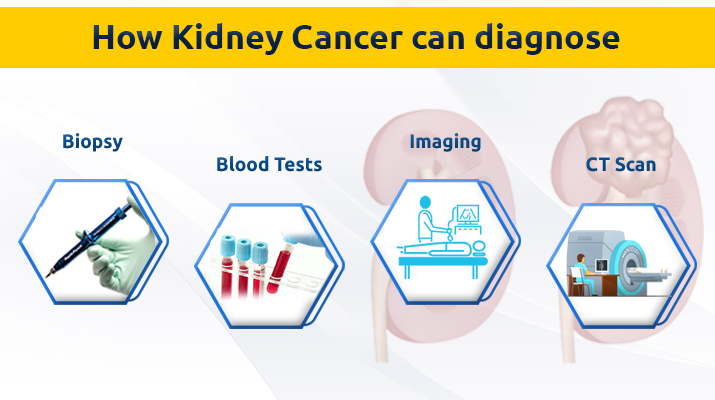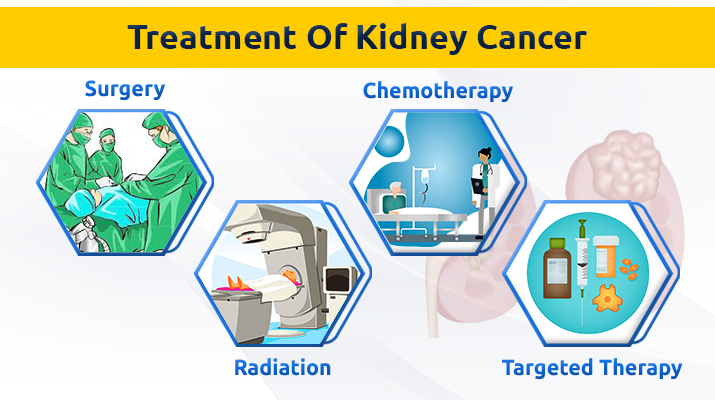What is Kidney cancer?
You have two kidneys, one on each side of the back above the waist. Kidneys filter blood, and the waste is carried in the urine, which is produced by microscopic tubules. Urine flows into the ureter tubes and down into the bladder. Cancer arises from the microscopic tubules inside the kidney. Although kidney cancer usually grows as a single mass within the kidney, a kidney may contain more than one tumor, or tumors may be found in both kidneys.
Types of Kidney Cancer
Renal cell carcinoma (cancer) (RCC) is the most prevalent form of kidney cancer. Types of RCC include clear cell, papillary, chromophobe and collecting duct carcinomas. Clear cell carcinoma accounts for 80% of all RCC cases, and most treatments are focused on this type.
Wilms’ tumor is a childhood cancer, responsible for 95% of pediatric kidney cancer cases.
Urothelial cancer of the kidney pelvis and ureter: Cancer of the urinary tract that occurs in the kidney or ureter is called urothelial carcinoma. It is not considered kidney cancer, although it is frequently called that in error.
Risk Factor Of Kidney Cancer
Anything that increases your chance of getting kidney cancer is called a risk factor. The biggest risk for kidney cancer is smoking.
Other kidney cancer risk factors include:
- Age: Most cases occur after age 50
- Gender: Men are more than twice as likely to get kidney cancer as women
- Obesity
- High blood pressure
- Exposure to asbestos, cadmium, and coke (used in making steel), benzene, herbicides and organic solvents
- Advanced kidney disease and long-term kidney dialysis
- Race: African-Americans have a slightly higher rate of kidney cancer
- Rare inherited conditions including von Hippel-Lindau disease or hereditary papillary renal cell carcinoma
- Family history of kidney disease
Not everyone with risk factors gets kidney cancer. However, if you have risk factors, it’s a good idea to discuss them with your doctor.
What are the Symptoms of Kidney Cancer?
Due to the location of the kidneys, many kidney cancer symptoms don’t show until the tumor has grown quite large. If there are symptoms, they vary from person to person.
The most common kidney cancer symptom is blood in the urine (hematuria), but hematuria can be caused by a variety of conditions so it doesn’t necessarily mean you have cancer.
- A lump or mass on the side or lower back
- Unexplained fever for a few weeks
- Rapid weight loss
- Lingering dull ache or pain in the side, abdomen or lower back
- Feeling fatigued or in poor health
- Swelling of ankles and legs
These symptoms do not always mean you have kidney cancer and may be caused by other conditions. However, it is important to discuss any symptoms with your doctor, since they may signal other health problems.
Book Appointment
Quick Contact
- Address 557A1/15C Gultekadi, Market Yard Pune, Maharashtra 411037
- Email social.prolife@gmail.com
- Phone +91-9607079019, +91-9607079029
How can it be diagnosed

At Prolife, our experts specialize in kidney cancer and use the very latest technology to pinpoint the exact extent and location of each kidney cancer tumor.
If you have been diagnosed with a kidney tumor or kidney cancer, it’s important to seek treatment as early as possible. Most tumors of the kidney are malignant (cancer), but some are benign (not cancer). There is no imaging test that can tell if a kidney tumor is benign or cancerous.
Kidney cancer diagnosis
If you have symptoms that may signal kidney cancer, your doctor will ask you questions about your health; your lifestyle, including smoking and drinking habits; and your family medical history.
One or more of the following tests may be used to find out if you have kidney cancer and if it has spread. These tests also may be used to find out if treatment is working.
- Blood and urine tests
- Imaging tests, which may include:
- CT or CAT (computed axial tomography) scans
- MRI (magnetic resonance imaging) scans
- Ultrasound
- Chest X-Ray
- Bone Scan
Stages of Kidney Cancer
If you are diagnosed with kidney cancer, your doctor will determine the stage of the disease. Staging is a way of classifying cancer by how much disease is in the body and where it has spread when it is diagnosed. This helps the doctor plan the best way to treat the cancer.
After a biopsy or surgery for removal of the tumor, a grade or nuclear grade is assigned to kidney cancer. The cancer grade is a measure of how likely the cancer is to spread. The pathologist assigns the grade after looking at the tumor cells under the microscope.
Once the staging classification is determined, it stays the same even if treatment is successful or the cancer spreads.
Kidney cancer stages
Stage 1: The tumor is 7 centimeters or smaller and is only in the kidney
Stage 2: The tumor is larger than 7 centimeters and is only in the kidney
Stage 3: Cancer is found in one of the following:
- The kidney and one nearby lymph node
- An adrenal gland or the layer of fatty tissue around the kidney, also may be in one nearby lymph node
- The main blood vessels of the kidney, also may be in one nearby lymph node
Stage 4: Cancer has spread to one of the following:
- Beyond the layer of fatty tissue around the kidney and possibly to one nearby lymph node
- To two or more nearby lymph nodes
- To other organs, such as the bowel, pancreas or lungs and possibly to nearby lymph nodes
Treatment

Surgeons can treat Kidney Cancer with surgery, radiation, chemotherapy, and drugs. The treatment you get will depend on:
- Which type of tumor you have and how many there are
- Whether it’s harmful
- If it has expanded to different sections of your body
- Surgery Surgery is the removal of the tumor. If the cancer has not grown beyond the kidneys, surgery to remove the tumor, part or all of the kidney, and possibly nearby tissue and lymph nodes, may be the only treatment needed.
- Laparoscopic surgery : During laparoscopic surgery, the doctor makes several tiny holes in the stomach, rather than the 1 larger hole used during a regular surgical procedure. The doctor then enters telescoping equipment into these small keyhole holes to fully eliminate the kidney or perform a partial nephrectomy.
- Radiation : This method involves using high-energy radiation to destroy cancer cells. It’s a lot like getting an X-ray only much more effective. It doesn’t harm. You might require to get radiation 5 days a week for several weeks.Radiation therapy is not as effective as a primary treatment for kidney cancer. It is very rarely applied alone to treat kidney cancer because of the damage it makes to the healthy kidney. Radiation therapy is used only if a patient cannot have surgery and, even then, usually only in regions where the cancer has grown and not on the primary kidney tumor. Most usually, radiation therapy is used when the cancer has developed to help ease signs, such as bone pain or swelling in the brain.Chemotherapy Chemotherapy is the use of drugs to kill cancer cells, normally by stopping the cancer cells’ ability to grow and distribute.A chemotherapy regimen, or schedule, normally consists of a specific number of cycles given over a set period. A patient may get 1 drug at a time or a combination of different drugs given at the same time.Targeted therapy It uses drugs that hit certain genes on tumor cells to kill cancer. This method limits harm to the healthy cells in your body, which can occur with radiation or chemotherapy.
Your surgeon will choose which drug is best for you by examining cells from your tumor first.
Specialized Kidney Cancer Treatments
With Laparoscopic surgery, Prolife offers unique options. Laparoscopic surgery requires specialized training. Our globally renowned team of physicians shows your treatment for the most benefit while reducing the impact on your body.
Dr. Sumit Shah is expertise in treating Kidney Cancer that has spread to other sections of the body. We offer Laparoscopic surgery program & as well as chemotherapy and targeted therapy options.
After Treatment: Reconstruction and Rehabilitation

Healing from Surgery
Most people who have Kidney cancer surgery heal without any problems. A fewer number of patients may have a slower recovery and need to wait for a little more.
A surgeon will give you guidance on how to take care of yourself, including your surgery, bathing, driving, and sexual activity. There will be information about yourself:
- Diet
- Exercise
- Pain medicine
After Treatment, you will be given a Daily Goals Checklist. Use that checklist to understand how you are doing every day.
Your Daily Goals Checklist
While you are in the hospital, you will have regular aims to help you recover. These aims include:
- Getting out of bed and being active
- Eating and drinking
- Controlling your pain
Follow-up appointments

After you’ve completed your treatments for Kidney cancer, follow-up care is very essential. Routine checkups can help find any changes in your health, and if cancer comes back (or “recurs”), it can be treated as soon as possible.
If your treatment has finished, follow-up appointments maybe every 3−6 months for the first couple of years and 6−12 months for the following 3 years.
Your doctor may check your CEA level
before you begin treatment and again after treatment to understand if it has come down.

